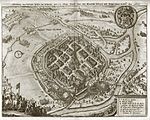J. K. Tyl Theatre
1902 establishments in Austria-HungaryArt Nouveau architecture in the Czech RepublicArt Nouveau theatresBuildings and structures in PlzeňRenaissance Revival architecture in the Czech Republic ... and 3 more
Theatres completed in 1902Theatres in PlzeňTourist attractions in the Plzeň Region

Josef Kajetán Tyl Theatre (Czech: Divadlo Josefa Kajetána Tyla) is a main theatre in Plzeň, Czech Republic. The theatre was built between 1899 and 1902 in the neo-renaissance style with some art nouveau elements to the design of Antonin Balsanek. Every year the theatre performs some 18 premieres of drama, operas, operettas, ballets or musicals. Since September 2014, actors of the theatre also perform at the New Theatre.In front of the façade stands a statue of Josef Kajetán Tyl by Alois Soper.
Excerpt from the Wikipedia article J. K. Tyl Theatre (License: CC BY-SA 3.0, Authors, Images).J. K. Tyl Theatre
Smetanovy sady, Pilsen Jižní Předměstí
Geographical coordinates (GPS) Address Phone number Website Nearby Places Show on map
Geographical coordinates (GPS)
| Latitude | Longitude |
|---|---|
| N 49.745416666667 ° | E 13.373361111111 ° |
Address
Divadlo Josefa Kajetána Tyla - Velké divadlo
Smetanovy sady 1129/16
301 00 Pilsen, Jižní Předměstí
Southwest, Czechia
Open on Google Maps











